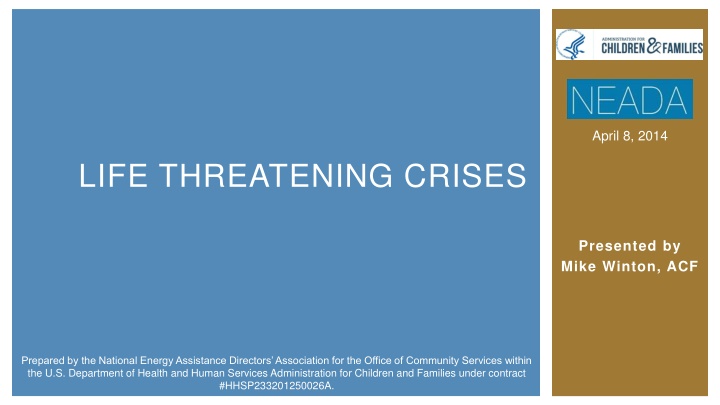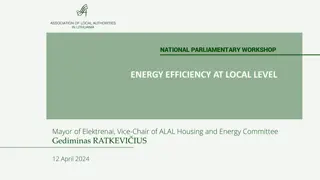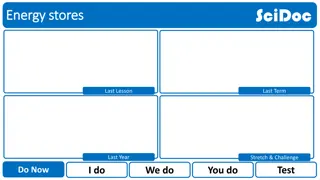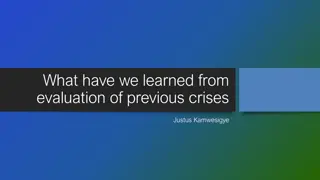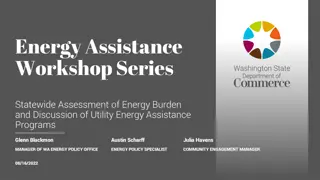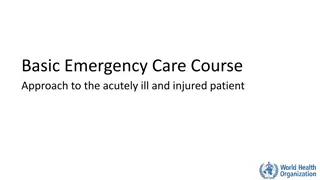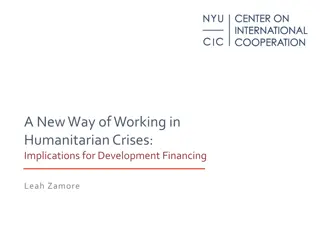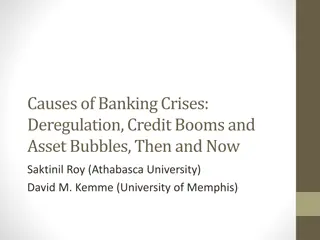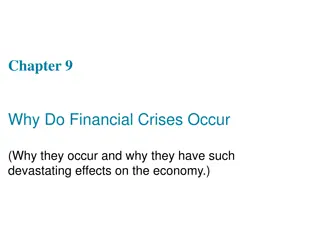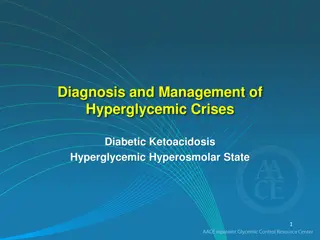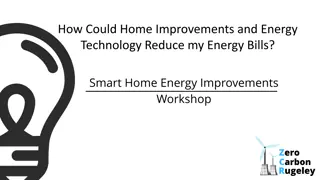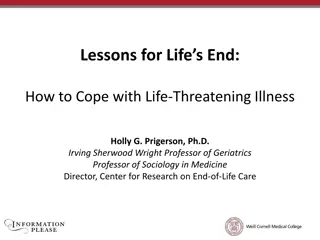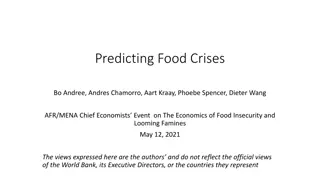Managing Life-Threatening Crises in Energy Assistance Programs
This document outlines statutory requirements, intervention concepts, crisis components, definitions of crisis and life-threatening crises, and the process of applying for crisis assistance in energy-related emergencies. Grantees must act promptly to resolve crises within specific timeframes, ensuring eligible applicants receive necessary interventions swiftly.
Download Presentation

Please find below an Image/Link to download the presentation.
The content on the website is provided AS IS for your information and personal use only. It may not be sold, licensed, or shared on other websites without obtaining consent from the author.If you encounter any issues during the download, it is possible that the publisher has removed the file from their server.
You are allowed to download the files provided on this website for personal or commercial use, subject to the condition that they are used lawfully. All files are the property of their respective owners.
The content on the website is provided AS IS for your information and personal use only. It may not be sold, licensed, or shared on other websites without obtaining consent from the author.
E N D
Presentation Transcript
April 8, 2014 LIFE THREATENING CRISES Presented by Mike Winton, ACF Prepared by the National Energy Assistance Directors Association for the Office of Community Services within the U.S. Department of Health and Human Services Administration for Children and Families under contract #HHSP233201250026A.
STATUTORY REQUIREMENTS For all Crisis Assistance: Set aside funds at least until March 15 for crisis intervention Have crisis intake locations that are geographically accessible to all clients Provide application intake assistance to infirm clients through submission of crisis application from home or transportation to intake sites Grantees must provide assistance to resolve the crisis Within 18 hours from the time a household applies for life- threatening crises Within 48 hours from the time a household applies for other crisis situations 2
CONCEPT OF INTERVENTION The statute does NOT require grantees to pay the vendor during the crisis timeframe. However, grantees must take some steps to prevent/resolve the crisis within that timeframe. Possibilities include: Calling the utility company and getting them to reconnect or delay shut-off based on a benefit pledge; Provide loaner electric heaters or blankets or warm clothes for a household that has no heat; or Arranging for temporary shelter. 3
CRISIS COMPONENT Two ways to manage crisis intake: Crisis application that is separate from regular LIHEAP benefit LIHEAP benefits tagged as fast track if client is in crisis situation 4
DEFINITION OF CRISIS AND LIFE-THREATENING CRISIS The statute defines energy crises as weather-related and supply shortage emergencies and other household energy- related emergencies. A grantee may further narrow and refine this definition, if desired. Grantees must set distinct definition for life-threatening crisis This is important because intake workers must know when the 18-hour rule is triggered versus the 48-hour rule. They also need to track when they provide the intervention. 5
APPLYING FOR CRISIS Grantees must determine eligibility and provide some form of intervention on an eligible application within 18 or 48 hours from when the client applies. It would be clearly erroneous to take, for example, 30 days to determine crisis eligibility and then provide an intervention. The crisis timeframe requires grantees to make a decision and take action on the application. 6
CRISIS BENEFIT TYPES Grantees can provide a wide range of crisis relief benefits, including, but not limited to: issuance of a LIHEAP benefit delivery of fuel repair or replacement of heating or cooling equipment purchase or loan of space heaters, oil tanks, blankets, sleeping bags or warm clothing emergency lodging relating to loss of household heat or air conditioning prevention of shutoffs payment of reconnection or pressure testing charges purchase or loan of window air conditioners or fans assistance with vendors, budget counseling, and case management other energy-related crisis assistance 7
IMPACT OF EXTREME WEATHER Consider the disproportionate impact of extreme temperatures for your area, especially on vulnerable populations Plan for and explain in your manuals what interventions will be available for such unexpected weather patterns: Cooling centers Heating centers Medical community alerts and referrals Home checks on homebound populations Establish coordination between local LIHEAP agencies and other social service and emergency response agencies 8
CRISIS AND UTILITIES Vendor agreements should include provisions addressing how the utility will respond in crisis situations. Agreements with delivered fuel vendors should include provisions on crisis fuel delivery during emergency weather events. 9
EXAMPLE: NEW YORK Type of Benefit: Crisis assistance Definition of regular crisis (48 hour rule): At imminent risk of losing heating fuel or utility service, which means: less than 10 days of deliverable fuel less than tank of oil, kerosene, or propane, or a notice of a termination or disconnection within 72 hours If heating equipment needs to be repaired or replaced, it must be because the system is detrimental to the health and safety of the household and household assets are less than $2,000 ($3,000 if household has a member 60 years or older) Life-Threatening Crisis (18 hour rule) Currently without heat or utility service to operate a heating source 10
EXAMPLE: ILLINOIS Crisis: Disconnected or Shut off notice for disconnection within 7 days Available for heating, as well as cooling if cooling is a medical necessity Life-threatening crisis: To prevent disconnection when the household has a documented life- threatening medical condition 11
TIPS FOR DEFINING CRISIS Clearly explain the utility service and deliverable fuel conditions, such as whether the service must already be shut-off or whether a disconnection is pending and within what timeframe Explain what conditions or criteria must be documented, such as certain medical conditions and income constraints. Avoid using the terms crisis and life-threatening in your definitions of crisis and life-threatening . Narrow the scope of the definition to restrict eligibility Consider distinguishing crisis conditions based on heating or cooling needs, such as winter versus summer programs 12
FEDERAL STATUTORY REFERENCE Section 2604(c) of the LIHEAP statute [42 U.S.C. 8623] requires: Of the funds available to each State under subsection (a), a reasonable amount based on data from prior years shall be reserved until March 15 of each program year by each State for energy crisis intervention. The program for which funds are reserved by this subsection shall be administered by public or nonprofit entities which have experience in administering energy crisis programs under the Low-Income Energy Assistance Act of 1980 or under this Act, experience in assisting low-income individuals in the area to be served, the capacity to undertake a timely and effective energy crisis intervention program, and the ability to carry out the program in local communities. The program for which funds are reserved under this subsection shall 13
SECTION 2604(C) OF THE LIHEAP STATUTE (1) not later than 48 hours after a household applies for energy crisis benefits, provide some form of assistance that will resolve the energy crisis if such household is eligible to receive such benefits; (2) not later than 18 hours after a household applies for crisis benefits, provide some form of assistance that will resolve the energy crisis if such household is eligible to receive such benefits and is in a life-threatening situation. (3) require each entity that administers such program-- (A) to accept applications for energy crisis benefits at sites that are geographically accessible to all households in the area to be served by such entity; and (B) to provide to low-income individuals who are physically infirm the means-- (i) to submit applications for energy crisis benefits without leaving their residences; or (ii) to travel to the sites at which such applications are accepted by such entity. 14
SUMMARY Statute requires every LIHEAP grantee to: provide crisis assistance, regardless of whether it is a separate component or application establish two separate definitions: crisis and life- threatening crisis track determination and intervention response timeframes (18 hours for life-threatening and 48 hours for regular crisis reserve sufficient crisis funding through March 15 15
ADDITIONAL RESOURCES ON CRISIS BENEFITS State grantee crisis definitions http://liheap.ncat.org/tables/FY2014/Crisis.pdf LIHEAP Statute section on crisis http://liheap.ncat.org/pubs/liheapstatute.htm#2604 section 2604(c) Tribal LIHEAP Manual on crisis http://liheap.ncat.org/Tribes/policy.doc, Establishing an Energy Crisis Intervention Program 16
CONTACT INFORMATION Mike Winton, Program Analyst Office of Community Services Administration for Children and Families 202-205-5961 James.winton@acf.hhs.gov 17
